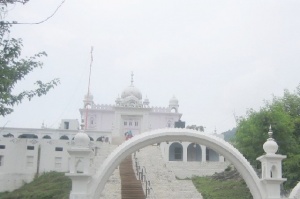Gurdwara Guru Ka Lahore
Guru Ka Lahaur, a cluster of three Gurdwaras near Basantgarh village in Bilaspur district of Himachal Pradesh and about 12 kilometers north of Anandpur Sahib in Punjab, is related to Guru Gobind Singh's marriage. The betrothal had taken place during the lifetime of Guru Tegh Bahdur, but the marriage had been postponed in view of the elder Guru's martyrdom in November 1675. Early in 1677, Jito Ji's father, Bhai Hari Jas, a resident of Lahore, came to Chakk Nannki (Anandpur Sahib) and proposed that the bridegroom's marriage party should go to Lahore and the marriage performed at an early and suitable date. The elders in the holy family considered that it was still not politic to go to Lahore. The young Guru said, We shall create a Lahaur here. The bride's family may come and reside in it, and the marriage may take place as agreed. Consequently, a temporary camp was set up near Basantgarh and named Guru Ka Lahaur. Bhai Hari Jas brought his family and relations there and the marriage took place on 23rd Har 1734 Bikrami/21st June 1677. Even after the camp had been wounded up, the place continued to be considered holy. A Gurdwara was established at the camp site to which two more were adder later close to nearby springs.
1) Gurdwara Anand Karaj Sthan Patshahi Dasvin - represents the spot where the marriage was performed. Its present building, a square hall with the domed sanctum in the middle of it, was constructed by Sant Seva Singh Anandgarhwale during the 1960s.
2) Gurdwara Triveni Sahib - enclosing a spring formerly called Karpa (lit. spear) Baoli, creating according to popular legend, by the Guru with a blow of his spear, is a domed square hall with a pavilion over the spring in front of the hall.
3) Gurdwara Paur Sahib - a small domed room with a verandah in front, near another spring is also based on legend similar to the one related to Triveni Sahib. In this case the spring is said to have been caused by the Guru's horse stamping its paur (hoof).

